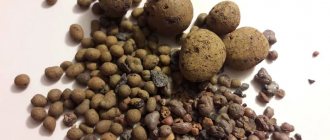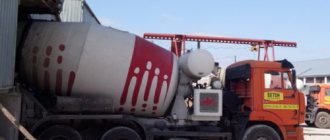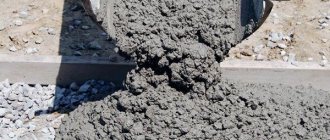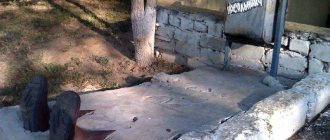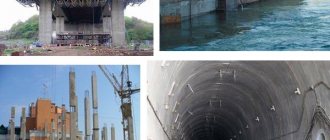Rheological properties of concrete mixture
A concrete mixture is a rationally composed and thoroughly mixed mixture of concrete components before the setting and hardening processes begin. The composition of the concrete mixture is determined based on the requirements for the mixture itself and for the concrete.
The main structure-forming component in a concrete mixture is cement paste. Regardless of the type of concrete, the concrete mixture must satisfy two main requirements: have good workability, corresponding to the compaction method used, and maintain the homogeneity achieved during preparation during transportation and placement. Under the influence of increasing force, the concrete mixture first undergoes elastic deformation, but when the structural strength is overcome, it flows like a viscous liquid. Therefore, the concrete mixture is called an elastic-plastic-viscous body, which has the properties of a solid and a true liquid. The property of a concrete mixture to liquefy under mechanical stress and thicken again in a calm state is called thixotropy.
What is the composition?
Description, physical and mechanical properties, basic and special structural characteristics of the concrete mixture are contained in regulatory documents GOST 7473–2010, GOST 26633–2012. Concrete consists of the main components - sand, cement, crushed stone, water. Classes and brands differ based on the ratio of the proportions of these components that make up the mixture.
View "GOST 26633-2012" or
View "GOST 7473-2010" or
Sand and crushed stone are the basis of the mixture. The use of these components increases the strength characteristics of the solution. Cement and water are required to bind all components. Thanks to them, it is possible to create a homogeneous consistency of the mass, on which class, technical and functional characteristics also depend. Taking into account the compositions and ratios of the components used, the following types of concrete are distinguished into classes:
The material can be made with the addition of limestone.
- Limestone. Average strength is 500-600 kgf/cm2. Used for the production of concrete grades M100, M150, M200, M250, M300, M350.
- Gravel. Practical and reliable material with a strength of 800-1000. It is a component of the M400, M450 brands.
- Granite. A very durable component used for heavy cement concrete grades M500 and above. Granite is used to make reliable and dense road concrete.
And also according to the composition criterion, there is a classification according to which concrete comes in 3 varieties:
- fatty;
- commodity;
- skinny.
Technical properties of concrete mixture
In the manufacture of reinforced concrete products and concreting monolithic structures, the most important property of a concrete mixture is workability (or workability), i.e. the ability to fill the mold with this compaction method while maintaining its uniformity.
To assess workability, three indicators are used: mobility of the concrete mixture (P), which is a characteristic of the structural strength of the mixture; hardness (R), which is an indicator of the dynamic viscosity of the concrete mixture; cohesion, characterized by water separation of the concrete mixture after it has settled.
The workability of a concrete mixture is characterized by the measured settlement (cm) of a cone (OC) formed from the concrete mixture to be tested. The mobility of a concrete mixture is calculated as the average of two determinations made from one sample of the mixture. If the cone settlement is zero, then the workability of the concrete mixture is characterized by rigidity. The stiffness of a concrete mixture is characterized by the time (s) of vibration required to level and compact the preformed cone of the concrete mixture in a stiffness tester.
Application based on characteristics
The calculator for calculating building materials for the foundation will help determine the amount of concrete for one batch in a concrete mixer or other container.
Cement concrete products of grades M100 - M250 are often used as auxiliary materials during the preparation and pouring of the foundation. To strengthen the structure, it is additionally recommended to use reinforced metal. When constructing multi-storey residential buildings, it is better to use concrete mixtures of grades M300 - M400. The additive “Penetron Admix” will help provide additional waterproofing, the frost resistance will be provided by a plasticizer such as SDB, and the primer “Beton-Contact” will help to ensure good adhesion of the surface to the finishing material. If you want to pour a durable and reliable cast floor, you should use a concrete solution of class M500, which is classified as heavy-duty.
Classification of concrete mixtures
The cohesiveness of the concrete mixture determines the uniformity of the structure and properties of concrete. It is very important to maintain the homogeneity of the concrete mixture during transportation, placement in the form and compaction. When compacting moving concrete mixtures, the constituent grains come together, and some of the water is pressed upward. Reducing the amount of mixing water when using plasticizing additives and increasing the water-holding capacity of the concrete mixture by correctly selecting the grain composition of aggregates are the main measures to combat the separation of moving concrete mixtures.
Volume weight
Depending on the volumetric weight, concretes are distinguished
- heavy (2,200–2,400 kg/m3) and light (1,200–1,800 kg/m3).
- cellular concretes have a volumetric weight from 300 to 1,000 kg/m3.
Depending on the volumetric weight, concretes are heat-conducting (“cold”) or low-heat-conducting (“warm”). The higher the volumetric weight, the more thermally conductive the concrete is. i.e. “colder”.
Solutions are divided according to the type of filler. When using a heavy filler, such as sand, the solution turns out to be heavy, i.e. “cold”, and when using a light filler (boiler or metallurgical slag, light rocks - tripoli, pumice, tuff) - light, i.e. “warm” .
Workability of concrete mixture
The amount of mixing water is the main factor determining the workability of a concrete mixture. Mixing water (B, kg/m3) is distributed between the cement paste (Vc) and the aggregate (Vzap): B = Vc + Vzap. The amount of water in the cement paste is determined by its rheological properties: ultimate shear stress and viscosity, and, consequently, the technical properties of the concrete mixture - mobility and rigidity.
The water requirement of Vzap aggregate is its important technological characteristic; it increases with an increase in the total surface of the filler grains and is therefore large for fine sands. To ensure the required strength of concrete, the water-cement ratio must remain constant, therefore an increase in water demand causes excess consumption of cement. With fine sands it reaches 15-25%, so fine sands should be used after enrichment with coarse natural or crushed sand and with plasticizing additives that reduce water demand
Reasons for underuse
Despite all the advantages of using modifiers, they are not yet popular enough in modern construction technology. This is also due to the banal lack of information among consumers about all the possibilities of these additives, and the erroneous opinion that almost all additives are made using a handicraft method, that is, a high-quality modifier of a well-known brand is purchased, diluted with cheap low-quality raw materials and presented as a new “development.”
The main buyers of various additives for concrete mixtures are concrete mortar plants, construction organizations, and factories for reinforced concrete structures.
In addition, the long-existing base for the use and development of additives is outdated and does not reach the level of development of modern science. Concrete additives are science-intensive materials, and their development requires very serious scientific investments.
The main consumers of modifiers are concrete mortar plants, construction organizations, factories of reinforced concrete structures. The greatest demand among consumers is for domestically produced modifiers, which are much cheaper than imported ones. When choosing, the main role is played by price and the lack of proper testing of imported additives due to the lack of laboratory facilities.
Imported modifiers are created taking into account the fact that the cement into which this product will be added has fixed characteristics. But domestic cements are not characterized by stable cement characteristics and therefore the additive may behave completely differently than intended. That is why it is highly undesirable to use imported modifiers without laboratory testing.
Not every enterprise has an equipped laboratory, and sometimes consumers simply do not want to bother with such research. Domestic manufacturers of modifiers focus on the domestic cement market, and it is precisely this additive, if all concrete manufacturing technologies are correctly followed, that will provide the declared characteristics.
Deformative properties of concrete
Under load, concrete behaves differently than steel and other elastic materials. The conglomerate structure of concrete determines its behavior under increasing axial compression load.
The area of conditionally elastic operation of concrete is from the beginning of loading to the compressive stress, at which microcracks form along the adhesion surface of the cement stone to the aggregate.
Experiments have confirmed that at low stresses and short-term loading, concrete is characterized by elastic deformation, similar to the deformation of a spring. The elastic modulus of concrete increases with increasing strength and depends on porosity: an increase in the porosity of concrete is accompanied by a decrease in the elastic modulus. With the same strength grade, the elastic modulus of lightweight concrete on porous aggregate is 1.7-2.5 times less than heavy concrete. The modulus of elasticity of cellular concrete is even lower. Thus, the elastic properties of concrete can be controlled by adjusting its structure. The modulus of elasticity of concrete in compression and tension is assumed to be equal to each other:
Eszh = Er = Eb.
Creep is the phenomenon of increasing concrete deformation over time under the action of a constant static load. Creep depends on the type of cement and aggregates, the composition of the concrete, its age, hardening conditions and humidity. Less creep is observed when using high-quality cements and dense aggregate - crushed stone from igneous rocks. Porous aggregate increases creep, so lightweight concrete has greater creep compared to heavy concrete. Premature drying of concrete worsens the structure and increases its creep. However, saturation of hardened concrete with water can cause an increase in creep. Creep and associated stress relaxation can play a negative role. For example, concrete creep causes loss of tension; in prestressed reinforced concrete structures.
Aggregate fractions
Fractions of crushed stone: 1 - crushed stone 5-20 mm, 2 - crushed stone 20-40 mm, 3 - crushed stone 25-60 mm, 4 - crushed stone 40-70 mm.
The size of the grain or stone is called the fraction. There are corresponding and main fractions of crushed stone. The main sizes include the following: 5-10 mm, 10-20 mm, 20-40 mm, 20-65 mm, 25-60 mm, 40-70 mm. The accompanying fractions include: 0-2 mm, 0-5 mm, 0-15 mm, 0-20 mm, 0-40 mm, 0-60 mm, 2-5 mm. Sometimes fractions with sizes of 70-120 mm and 120-150 mm are used. Granite crushed stone of fractions 5-20 mm is in greatest demand in our market. In the production of concrete, asphalt and reinforced concrete structures, crushed stone of a fraction of 5-15 mm is sometimes used.
Granite crushed stone of fractions 20-40 mm, 20-65 mm, 25-60 mm and 40-70 mm is used in the repair and construction of railway embankments, embankments of highways, tram lines, when laying foundations and constructing buildings. Crushed stone is the main one of all natural stone materials used in construction.
Shrinkage and swelling of concrete
When hardening in air, concrete shrinks, i.e. concrete contracts and the linear dimensions of concrete elements are reduced. Shrinkage consists of moisture, carbonation and contraction components.
Due to concrete shrinkage, shrinkage stresses arise in reinforced concrete and concrete structures; therefore, long-term structures are cut with shrinkage joints to avoid the appearance of cracks. Indeed, with concrete shrinkage of 0.3 mm/m in a structure 30 m long, the total shrinkage is about 10 mm. Solid concrete dries out on the outside, but remains wet on the inside for a long time. Uneven shrinkage causes tensile stresses. outer layers of the structure and the appearance of internal cracks at the contact with the aggregate and in the cement stone itself.
To reduce shrinkage stresses and maintain the solidity of structures, they strive to reduce the shrinkage of concrete. Cement stone has the greatest shrinkage. The introduction of filler reduces the amount of binder per unit volume of material, thereby forming a kind of frame of filler grains that prevents shrinkage. Therefore, the shrinkage of cement mortar and concrete is less than that of cement stone.
The concrete of the external parts of hydraulic structures and cement-concrete roads is periodically moistened and dried. Fluctuations in concrete moisture cause alternating shrinkage and swelling deformations, which can cause microcracks and concrete failure.
Fire resistance
This property shows the ability to withstand high temperatures, while concrete must maintain strength for a long time. When heated, all the water contained in concrete evaporates, including chemical water, thereby lowering the combustion temperature. However, structures should not be subjected to prolonged heating, because the material may lose strength.
There is special heat-resistant concrete for furnaces, industrial pipes, and furnaces. It consists of aluminous cement and fire-resistant fillers.
One more property needs to be mentioned - average density. This is the so-called ratio of the mass of the material to its total volume. The average density of concrete should be less than 100 percent.
Its strength characteristics depend on the average density of concrete, and this is a very important property for structures and structures.
Frost resistance of concrete
The frost resistance of concrete is determined by alternately freezing in a refrigerator at a temperature of 15 to 20 ° C and thawing in water at a temperature of 15-20 ° C concrete samples of cubes with edge sizes of 10, 15 or 20 cm (depending on the largest aggregate size). Samples are tested after 28 days of storage in a normal hardening chamber or 7 days after heat treatment. Control samples intended for compression testing at an equivalent age are stored in a normal hardening chamber. The frost resistance of concrete depends on the quality of the materials used and the capillary porosity of the concrete. The volume of capillary pores has a decisive influence on the water permeability and frost resistance of concrete. The frost resistance of concrete increases significantly when the capillary porosity is less than 7%.
Strength, brand, class of concrete. Determination methods. Control samples.
The choice and purchase of a specific type and brand (class) of concrete mixture is determined by your project. If there is no project, then you can trust the recommendations of your builders. They can recommend concrete of a particular brand or class. If you have some doubts about the competence of your builders, you can try to figure it out yourself.
The numbers of the concrete grade (m-100, m-200, etc.) indicate (on average) the compressive strength in kgf/sq.cm. Compliance with the required parameters is checked by compression
cubes or cylinders cast from a sample of the mixture and kept for 28 days of normal hardening.
In modern projects, concrete is indicated in classes. In general, a concrete class is a parameter similar to a grade, but with minor nuances: grades use the average strength value, while grades use guaranteed strength with a coefficient of variation of 13%. However, this does not matter to you. I won’t fool you with strength variation coefficients and other technical nuances. The design documentation, if you have it, of course, should indicate what class of concrete should be used. In accordance with ST SEV 1406, all modern design requirements for concrete are specified in classes. I don’t know to what extent this is observed, because for some reason 90% of construction organizations order concrete in stamps :-).
The main thing for you is that the concrete brought to you matches the brand that you actually ordered. Of course you can check, but not right away. What's worth doing.
When unloading concrete, take a sample and cast a couple of cubes measuring 10x10x10 cm or 15x15x15 cm. To do this, you can put together special shapes of the required size from planks. Before pouring concrete into molds, it is advisable to moisten the boxes so that dry wood does not take a lot of moisture from the concrete, thereby negatively affecting the process of cement hydration. The poured mixture must be pierced with a piece of reinforcement or something similar: poke it into the mixture, like pounding mashed potatoes, so that unfilled spaces (shells) do not form in the poured sample, excess air comes out, and the mixture becomes denser. You can also compact the mixture by hitting the sides of the boxes with a hammer. Store the cast cubes at medium temperature (about 20 degrees) and high humidity (about 90%).
After 28 days, you can bring all this splendor to any independent laboratory with a clear conscience. They will suppress all this for you and give you a verdict - whether the concrete corresponds to the declared brand or does not correspond. However, it is not necessary to wait 28 days; for this, there are intermediate stages of hardening at the age of 3, 7, 14 days. During the first 7 days, concrete gains about 70% of its design strength (naturally, subject to normal temperature). In damp and cold seasons, the setting time of concrete and its hardening period increase significantly.
What nuances may arise when collecting and storing sample cubes:
- Do not dilute concrete with water in a concrete mixer truck.
- Take samples directly from the concrete mixer tray.
- Thoroughly compact the concrete mixture in the molds by bayoneting (mashed potatoes)
- Store samples in proper conditions: not in the sun or on the stove :-)) It is better in a cool basement, or just in the shade.
That's all about the cubes. If you suddenly forgot to take samples, but would like to know that everything is in order, contact an independent laboratory that can measure the strength on site. For this purpose, there are so-called non-destructive methods for studying strength: testing using shock pulse methods using a sclerometer. People call it tapping concrete. Ultrasonic and other methods for determining strength are also used.
Let's move on to other important parameters of concrete. Namely:
Waterproofness of concrete
With a decrease in the volume of capillary macropores, water resistance decreases and at the same time the frost resistance of concrete increases. To reduce water resistance, compacting (sodium aluminate) and water-repellent additives are introduced into concrete during its manufacture. Petroleum products (gasoline, kerosene, etc.) have a lower surface tension than water, so they penetrate through ordinary concrete more easily. To reduce the filtration of petroleum products, special additives (ferric chloride, etc.) can be added to the concrete mixture. The permeability of concrete to water and oil products decreases sharply if expanding cement is used instead of ordinary Portland cement.
Thermal conductivity
Thermal conductivity is the ability of a material to conduct heat.
The denser the material is in its structure, the more thermally conductive or “colder” it is; the more porous it is, the “warmer” it is. The thermal conductivity of a material also depends on the moisture content of the material. Water filling pores or voids in a material conducts heat, so a wet material is more thermally conductive.
Based on such considerations, ordinary beyun is not suitable for use as a wall material in residential construction. In construction technology, concretes with a porous structure are used for these purposes. They are characterized by lower thermal conductivity and therefore can be used as materials for wall enclosures. Such concretes include:
- a) concrete with light aggregates (metallurgical and boiler slag, expanded clay, pumice, etc.);
- b) large-porous (sandless) concrete produced from binder, water and coarse aggregate - light or ordinary;
- c) cellular concrete, which is characterized by the presence of closed air pores distributed throughout the entire mass of the material, which determines the low volumetric weight and high thermal insulation properties of cellular concrete products.
The most common main methods for producing cellular concrete are:
- a) the use of gas-forming substances (aerated concrete);
- b) the use of pre-whipped foam (foam concrete, foam silicate, foam gypsum, foam slag, etc.);
- c) introducing an excess amount of water into the mixture followed by its evaporation.
Abroad, the predominant method for producing cellular materials is based on gas-forming substances (aluminum powder). In Russia, a method based on mixing cement paste with pre-whipped foam is widely used.
Foam-based cellular concrete is obtained by hardening a mass prepared from a binder, filler, water and a foaming agent. To obtain such a mass, the mortar or dough must be of cast consistency; mixing must be done carefully.
Foam concrete mixers are used to prepare cellular concrete.
Various foaming agents are used - glue rosin, saponin and resin-saponin, aluminosulfonaphthene, HA, casein-rosin, liquid glass, etc.
The most common types of cellular materials include:
- foam concrete, obtained by mixing cement paste or mortar with separately prepared foam;
- foam silicate obtained by mixing lime-sand mortar with foam.
Similarly to what is indicated, when mixing a lime-sand solution with gas-forming substances, gas silicate can be obtained.
By analogy with concrete, solutions prepared with porous aggregate (slag, etc.) are classified as warm solutions.
Thermophysical properties of concrete
Thermal conductivity is the most important thermophysical characteristic of concrete, especially used in building envelopes.
The thermal conductivity of heavy concrete in an air-dry state is 1.2 W/(m°C), i.e. it is 2-4 times greater than that of lightweight concrete (on porous aggregates and cellular). High thermal conductivity is a disadvantage of heavy concrete. External wall panels made of heavy concrete are made with an inner layer of insulation.
The heat capacity of heavy concrete varies within a narrow range of -0.75-0.92 W/(m.C°). The linear coefficient of thermal expansion of concrete is about 0.00001 °C, therefore, with an increase in temperature by 50 °C, the expansion reaches approximately 0.5 mm/m. To avoid cracking of large structures, they are cut with temperature-shrinkage seams.
The coarse aggregate and mortar that make up concrete have different coefficients of thermal expansion and will deform differently as temperatures change.
Large temperature fluctuations (more than 80°C) can cause internal cracking of concrete due to different thermal expansion of coarse aggregate and mortar. Characteristic cracks propagate along the surface of the aggregate, some of them forming in the solution and sometimes in weak aggregate grains. Internal cracking can be prevented if care is taken to select concrete components with similar thermal expansion coefficients.
Water resistance
Water resistance is the resistance of concrete to moisture. To determine this parameter, two samples are used - dry and wet. The first and second samples are tested by applying pressure to the press. The strength coefficient of concrete saturation with moisture should be more than 0.8. Water resistance is also affected by hydrate formations with low solubility. Thanks to all this, concrete is considered one of the waterproof materials for structures. In other words, moisture resistance is especially important for buildings with the greatest risk of fire: platinum, piers, rumors.


